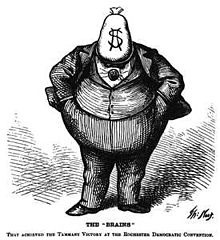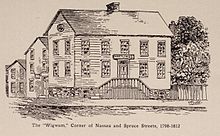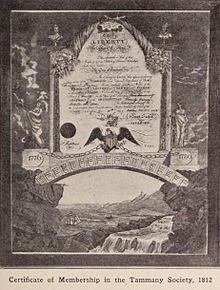Tammany Hall
Tammany Hall was a political clique in New York founded in 1786 as the Tammany Society. The name is derived from their meeting place, the Tammany Hall. It was the organization of the Democratic Party in New York City and controlled politics in the city for decades. Tammany gave voice to the city's immigrants and the lower classes, but at the same time the organization exploited these groups with considerable ruthlessness to pursue its own political goals. In particular, in the second half of the 19th century, Tammany Hall becamenotorious for scandals and the misuse of city resources and posts as a means of supplying the party's clientele and attracting financial support. To this day, Tammany Hall is considered a synonym for corrupt party politics ( party machines ), especially in large cities.
etymology
The name is derived from the office of the Democratic Party in New York City , where Tamanend (also called Tammany) goes back to a chief of the Lenni Lenape and friend of William Penn , founder of Pennsylvania .
history
founding
The Tammany Society in Philadelphia existed since 1772; it stood for unrestricted trade, unrestricted federalism and independence from a central government.
As George Washington at the first United States presidential election of 1789, the first US president , was founded William Mooney in New York City on May 12, the Society of St. Tammany ; the meeting place was called Tammany Hall . William Mooney's name first appeared as the Grand Sachem of the Tammany Society in 1789 and thereafter held important positions for the next 30 years as Grand Sachem, Sachem or Chairman of important committees. After the Peace Treaty of 1783, John Pintard came to New York from New Jersey, who is said to have written the statutes of every major society, as well as the first constitution of the New York Tammany Society. The goals of the society are briefly stated in the second paragraph of the Public Constitution as follows:
"It shall connect in the indusssoluble Bonds of patriotic Frendship, American Brethren, of known attachment to the political rights of human nature, and the Liberties of this country."
The society saw itself from the beginning as a party-political institution and founded the Tammany Hall Party in 1811 .
“Right from the start, the Tammany-Hall Party has used every means to cheat in elections or to heave its own people into lucrative offices. The pressure of modern mass influence through propaganda did not exist back then. "
The Tammany Hall stood for clientelism and corruption . A series of scandals began in the USA from 1817 onwards. B. Ruggles Hubart, actually Sheriff of New York, with $ 68,000. Robert Swartwout was able to stay on the Tammany Society's presidium despite embezzling $ 68,000.
William Tweed

William Tweed, in particular , openly admitted his illegal activities. In 1852 Tweed was elected a Democrat to the city council, in 1853 he became a member of the House of Representatives for this party . In 1857 Tweed sachem (section head) of the St. Tammany Society , in 1863 grand sachem (leader) and thus also chairman of the Democratic Party in New York. In this position, Tweed was the defining figure of New York politics and became State Senator in 1868 .
In the years of his political career, Tweed amassed a fortune in the tens of millions. Under his leadership, the St. Tammany Society received an additional $ 200 million from the public purse. This was done, among other things, by setting up control commissions that had to approve construction projects. In 1858, for example, the construction of the New York County Court House , which was initially estimated at US $ 250,000, cost the city more than US $ 12 million last. Most of the money went to the Tammany Society , whose members also controlled the companies involved in the construction.
In addition, Tweed made use of a wide range of unfair means to keep power and to keep enriching itself. Immigrants were illegally granted rights to stay in exchange for bribes . Officials and elected officials were also intimidated or bribed on their part. In addition, there were election fraud in New York , which could be traced back to Tweed himself. Tweed also indirectly controlled the press by making the newspapers docile by placing well-paid advertising contracts from the local community or members of the Society.
Tweed was overthrown significantly by the well-known cartoonist Thomas Nast , who published in Harper's Weekly magazine and denounced the system of corruption and political arbitrariness surrounding Tweed in his drawings.
After the election of Ulysses S. Grant as president, he appointed Edwards Pierrepont as federal prosecutor for the southern borough of New York. He held this office until 1870, after which he acted as a member of the Committee of Seventy against corruption in New York around the party chairman William Tweed in Tammany Hall. In 1873 he turned down the president's offer to go to Russia as envoy because, in his opinion, the fight against corruption was not yet over. It was not until 1874 that Tweed was sentenced to twelve years imprisonment for the massive corruption.
Michael Tuomey
In connection with the Swill milk scandal , Alderman Michael Tuomey (aka "Butcher Mike") , who grew up in the area around Tammany Hall, was able to prevent any further investigation. It was a food scandal involving milk from cows that were kept under appalling hygienic conditions in the vicinity of the Irish-dominated distilleries and that were poorly fed with mash residues. The milk obtained in this way was also adulterated and mixed with starch and rotten eggs, among other things, it was mainly used as baby food for the lower class and was held responsible for rampant child mortality.
Party machines
The intense political competition in the USA during the Gilded Age (approx. 1876–1914) led to extensive advertising campaigns and costly election campaigns . Events, promotional materials and lengthy speeches shaped this political time. All of this was organized without fixed, reliable party structures.
In addition to New York, so-called party machines developed in many other cities and individual states . The aim of these informal party political organizations was to win enough votes for upcoming elections. They rely on a strictly hierarchical organization. At the top was the boss William Tweed , followed by tenement officers and the simple members of the machine . With the help of sometimes illegal means such as corruption and blackmail, the party machines initially brought city districts and city administrations under control. Based on this, they strived for power in counties and states and ultimately held so much power that they could honor party donations or open support with official offices, state contracts or the like.
To this day, historians are divided on the assessment of party machines. On the one hand, the machines, especially the Tammany Hall , encouraged illegal activities such as corruption , extortion and street violence and thus became the pioneers of mafia-like structures in the USA. For example, criminal Irish gangs such as the Roach Guards and Dead Rabbits were used for election campaign purposes in the 1850s . In the 1920s in New York City it was their successors like the Eastman Gang . Due to waves of immigration from Italy , the focus of nationality among immigrants had shifted, and the Five Points Gang was used here to violently win votes. In Chicago there were B. the Ragen's Colts . The gangs thus enjoyed political protection for their illegal activities; Frank Ragen even became the Chicago Police Chief.
On the other hand, city / communal services have been organized and great successes have been achieved in the field of immigrant integration. In addition, the party machines produced some important politicians, including US President Franklin D. Roosevelt .
literature
in order of appearance
- Tammany Society, or Columbian Order (NY): Lease of Tammany Hall . Baptist & Taylor, New York 1864, therein pp. 19-20: Charter of Tammany Society ( archive.org ).
- Talcot Williams: Tammany Hall . In: New York City History Club (Ed.): Half Moon Series. Papers on Historic New York. Volume 2, No. 2. GP Putnam's sons, New York 1898, pp. 33-79 ( Textarchiv - Internet Archive ).
- Edwin P. Kilroe, Abraham Kaplan, Joseph Johnson: The Story of Tammany . Democratic Organization, New York County, New York 1924 ( Text Archive - Internet Archive ).
- Alfred Connable, Edward Silberfarb: Tigers of Tammany. Nine men who ran New York . Holt, Rinehart, and Winston, New York 1967.
- Robert Lacey: Little Man. Meyer Lansky and the gangster life . Little, Brown and Company, Boston 1991, ISBN 0-316-51168-4 , pp. 56-58 (History of Tammany Hall).
Web links
- Tammany Hall left . davidpietrusza.com (English)
Individual evidence
- ↑ Edwin P. Kilroe, Abraham Kaplan, Joseph Johnson: The Story of Tammany . Democratic Organization, New York County, New York 1924, p. 24.
- ↑ a b Dagobert Lindlau : The Mob. Organized Crime Research. dtv, Munich 1989, ISBN 3-423-11139-9 , p. 91 ff.
- ↑ The Swill-Milk Nuisance. In: The New York Times. June 8, 1858, Retrieved June 19, 2019 .
- ↑ Bee Wilson: Swindled . Princeton University Press, 2008, p. 162.




